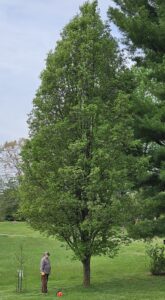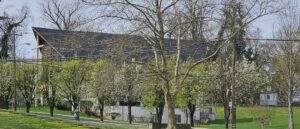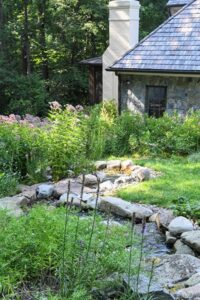The Ubiquitous Callery Pear

Photo by Gena Breakiron
Travel anywhere in Virginia during March, and every vista will be inundated by the white-flowering Callery pear trees (Pyrus calleryana). They are especially noticeable, as they are the first blooming trees of spring, blooming well before our native trees. They grow in dense thickets in every area where birds can drop the seeds. Fallow fields and roadsides, wooded areas and medians and even forests. No area is safe from this non-native, invasive tree.
Don’t be fooled by the beauty of the flowers. Most people agree they emit a strong fishy odor, but this is not the worst problem with this ever-present tree.

Photo by Gena Breakiron
The Callery pear tree, best known as the cultivar, Bradford pear, has become a pervasive nuisance. Its ability to grow easily and emit allelochemicals, preventing other plants from growing or thriving nearby, have allowed it to outcompete native species and create a monoculture that supports few native animals. Additionally, its abundance of opaque leaves robs sunlight from native trees that would have developed in the natural progression of a native forest.

Photo by Gena Breakiron
The Callery pear and its many cultivars were first introduced to the U.S. in the 1960s. They originated in Asia. They were widely planted along neighborhood streets and in many home and commercial landscapes. The trees were inexpensive, were easily obtained and could readily grow in any type of soil. However, the Bradford cultivar had weak branch angles, which caused many mature trees to succumb to wind, snow or other natural events. This trait made them a danger to humans and structures, and prompted the development of other, hardier cultivars.
Although the Callery pear was purported to be sterile, pollination occurred when other cultivars became available. This allowed for the development of a small fruit. While it is not considered edible by humans, it became attractive to birds, who have carried the seeds far and wide through their droppings. In addition, these new seedlings revert to the genes of the original parent plants and develop undesirable traits. The most significant of these characteristics being sharp thorns. This can make handling and removing these trees very difficult, as the thorns are very tough and have been known to puncture tractor tires!

Removing Callery pear trees will help to prevent their spread. A cut stump, however, will produce many sprouts, so the stump will need to be treated with an herbicide to prevent regrowth. For your safety, it is best to hire a certified arborist to remove and treat your tree(s).
If you choose to cut and treat the tree yourself, be safe. Wear protective equipment. When using an herbicide remember, the label is the law. Read all information carefully and use it with care. Protect yourself. The Virginia Department of Forestry (VDOF) has a great article on the Callery pear. You can read all about removing and treating the Callery pear tree here.

Photo by Gena Breakiron
Last spring, the VDOF placed a bounty on Callery pear trees. Homeowners in Virginia could remove the invasive trees from their property and in exchange they would receive a 2 gallon native tree to plant. There is a limit of 3 trees per household, and the trees must come from your personal property. You can check with the VDOF to be sure they will offer the program again this year, and you will need to preregister for the event, as they have a limited number of trees to exchange.
Although it is a tragic way to teach, I believe there is something to be learned by the inundation of this prolific non-native species. We need to take better care of our ecosystems. We need to plant native species. A native species is one that naturally grew in a particular region before the introduction of new people and their plants. In the U.S., that would be before the Europeans arrived and long before we started importing plants from other countries.

Native species have the benefit of being adapted to their environment. Which means they can maintain or improve soil quality, save water, reduce erosion, and most importantly, benefit native wildlife. Wildlife survival depends upon native plants for food and shelter. Healthy native forests are less susceptible to non-native invasions.
Take a look at your own landscape. Is there room for improvement? Could you slowly replace some of your non-native plants with natives? Would you like to see more native pollinators and other wildlife return? Could you make a “wild” area of your yard, dedicated to supporting wildlife? It doesn’t have to be a drastic change. Work at a pace you can afford, both in time and dollars. If you’re interested, the Piedmont Master Gardeners (PMG) have a program called Conservation Landscaping (for which there is a small fee). They can advise you how to proceed with your goals. If you are interested in obtaining more information about this program you can call or email the PMG Help desk.
References
VA Forestry-management practices
Commonwealth of VA invasive Callery Pear